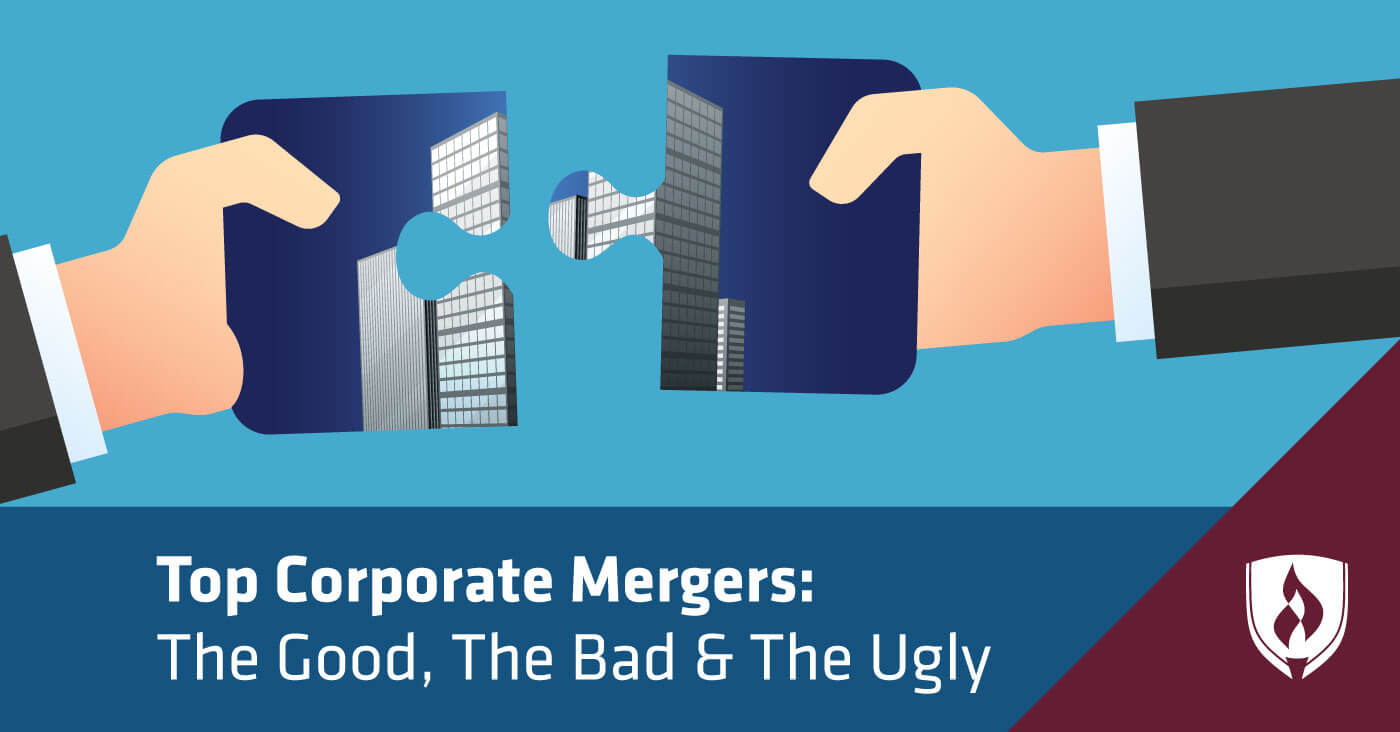
Without mergers and acquisitions, many of the most well-known brands and companies would not be where they are today. Some merged companies are so successful we can’t remember a time when the two were distinct. Where would Disney be without Pixar, or J.P. Morgan without Chase?
At the same time, the history of mergers and acquisitions has had its fair share of failures. It’s sometimes shocking to discover why one company has suddenly disappeared after being acquired and run into the ground by another. Some of the most famous mergers are those that have lost billions, left executives plagued by their failures and even caused companies to go bankrupt.
As someone with an interest in business, it’s important to have a grasp of what makes these mergers and acquisitions successful and what causes them to flop. Take a moment to get up-to-speed with these examples of the good, bad and ugly corporate mergers and acquisitions.
The good…
Disney & Pixar
Mickey and Nemo. Pinocchio and Buzz Lightyear. Cinderella and Lightning McQueen. The merger of the legendary Walt Disney and “everything-we-create-kids-adore” Pixar was a match made in cartoon heaven. Disney had released all of Pixar’s movies before, but with their contract about to run out after the release of “Cars,” the merger made perfect sense. With the merger in 2006, the two companies could collaborate freely and easily.
Did the merger work? Well, take a look at the successful movies that Disney-Pixar has given birth to since: WALL-E, Up, Brave and Inside Out. The merger didn’t just enable the two to collaborate, but also helped to breath new air into Disney’s other divisions. First Tangled and more recently Frozen have garnered huge attention at the box office and beyond, with Frozen becoming the fifth-highest grossing movie ever!
Sirius & XM radio
In July of 2008, satellite radio officially had one provider when Sirius Satellite Radio joined forces with rival XM Satellite Radio. The merger was officially announced more than a year prior, but the actual merger was delayed due to one tiny problem – when satellite radio first began in 1997, the FCC granted only two licenses under one condition: that either of the holders would not acquire control of the other.
Oops! So Sirius and XM filed the proper paperwork with the FCC, allowed the FCC to investigate the merger, and waited patiently for the approval they needed. Today, 70 percent of new cars come with SiriusXM pre-installed and a free 3-month trial and net income and revenue continue to increase.
Exxon & Mobil
Big oil got even bigger in 1999, when Exxon and Mobil signed an $81 billion agreement to merge and form ExxonMobil. Not only did it become the largest company in the world, it reunited its 19th century former selves, John D. Rockefeller’s Standard Oil Company of New Jersey (Exxon) and Standard Oil Company of New York (Mobil). The merger was so big, in fact, that the FTC required a massive restructuring of many of Exxon & Mobil’s gas stations, in order to avoid outright monopolization (despite the FTC’s unanimous approval of the merger.)
ExxonMobil remains the strongest leader in the oil market, with a huge hold on the international market and dramatic earnings. So was the merger a success? Absolutely! Some even predict that after Shell’s recent acquisition of BG Group, that ExxonMobil is about to make yet another big move in oil by merging again. Only time will tell!
The bad…
New York Central & Pennsylvania Railroad
Corporate mergers don’t always work out, and in the history of mergers and acquisitions, Penn Central sticks out as one of the poorest. In 1962, a time when transportation trends were shifting towards super highways and air-travel, the Pennsylvania Railroad Company and the New York Central Railroad Company decided to merge and form Penn Central. The merger was officially approved in 1968, only for it to file for bankruptcy just two years later.
With 4.6 billion in assets at the onset, it seemed shocking this could happen. But strict regulations, inflating labor costs and executive clashing all came together like a corporate Bermuda triangle. Thousands were affected by the bankruptcy, and it’s safe to say this was one merger that utterly flopped.
Daimler Benz & Chrysler
In 1998, Mercedes-Benz manufacturer Daimler Benz merged with U.S. auto maker Chrysler to create Daimler Chrysler for $37 billion. The logic was obvious: to create a trans-Atlantic, car-making powerhouse that would dominate the markets. But by 2007, Daimler Benz sold Chrysler to the Cerberus Capital Management firm, which specializes in restructuring troubled companies, for a mere $7 billion.
So what happened? It may be another case of corporate culture clash. Chrysler was nowhere near the league of high-end Daimler Benz, and many felt that Daimler strutted in and tried to control the folks on the Chrysler. Such clashes tend to undermine a new alliance. Combine that with dragging sales and a recession, and you have a recipe for corporate divorce and another example of a less-than-stellar corporate merger.
Yahoo & Facebook (almost!)
Sometimes bad mergers or acquisitions can be avoided, with one company choosing to stick it out on their own. In 2006, Yahoo saw the blossoming Facebook as a youngster with a promising future. Yahoo made an offer to acquire the company for $1 billion, but Facebook gave a hard no. CEO Mark Zuckerberg was just about to launch Facebook’s newsfeed and anticipated the company would be worth much more than Yahoo’s offer.
He couldn’t have been more right. Today Facebook is worth around $38 Billion, earning $12.47 billion in 2014 alone!
The ugly…
Sears & Kmart
Towards the end of the 20th century, department store legend, Sears, found itself struggling to stay afloat amidst the successes of big-box stores like Target and Walmart, and high-end department stores like Saks Fifth Avenue. Hedge-fund investor Eddie Lampert, whose hedge fund controlled Kmart, decided to acquire Sears and merge the two companies. The merged companies became Sears Holdings in 2005 and seemed to be a promising endeavor at the time.
However, the two merged companies continued their downward spiral, with some blaming Sears’ “identity crisis” as a carrier of clothes, home-goods and appliances with no strong niche or brand. Others say their strategic investments for the future were lacking, rendering their strategy unsustainable.
Whatever the causes, it’s clear the acquisition has been a failure so far, and the future doesn’t look promising. Sears Holdings is speculated as the next big retail failure, having lost 7 billion over the past four years.
AOL & Time Warner
At the height of the Internet craze, two media companies merged together to form (what was seen as) a revolutionary move to fuse the old with the new. In 2001, old-school media giant Time Warner consolidated with American Online (AOL), the Internet and email provider of the people, for a whopping $164 billion. It was considered a combination of the best of both worlds – but boy was that false!
Though on paper the merge occurred, the cultures of these two dynamically different companies never did . The dot-com bubble burst and the decline of dial-up Internet access spelled disaster for the future. In 2003, AOL/Time Warner reported a $45 billion dollar write-down which lead to a $100 billion dollar yearly loss.
Finally, in 2009, the two companies finally split in a sort of corporate divorce.
Quaker & Snapple
In 1994, grocery store legend Quaker Oats acquired the new-kid-on-the-block, Snapple, for $1.7 billion. Fresh from their success with Gatorade, Quaker Oats wanted to make Snapple drinks their next success story. Despite criticisms from Wall Street that they paid $1 billion too much for the fruity drink company, Quaker Oats dove head-first into a new marketing campaign and set out to bring Snapple to every grocery store and chain restaurant they could.
However, their efforts failed miserably. Snapple had found its niche in small, independent stores and gas stations, backed by a quirky and fun advertising strategy. Quaker didn’t seem to grasp the Snapple identity and after just 27 months, sold Snapple for $300 million. For those of you doing the math, that’s a loss of $1.6 million for each day that the company owned Snapple – OUCH!
Big business decisions
You’ve now been educated on examples of successful and unsuccessful corporate mergers and acquisitions. Sometimes joining forces makes perfect sense and they reap the rewards. Other times it can be too good to be true, ending in despair.
It’s clear that business leaders have a difficult job in making strategic decisions to drive the future of their respective companies. Do you think you have what it takes to join their ranks? Learn more about the Top Management Positions for Future Business Leaders.
RELATED ARTICLES:
- 15 Business Communication Tips to Help You Conquer the Corporate World
- Top Professional Business Associations for Business Students
AUTHOR’S NOTE: This article was originally published in Sept. 2009. It has since been updated to reflect information relevant to 2015.




